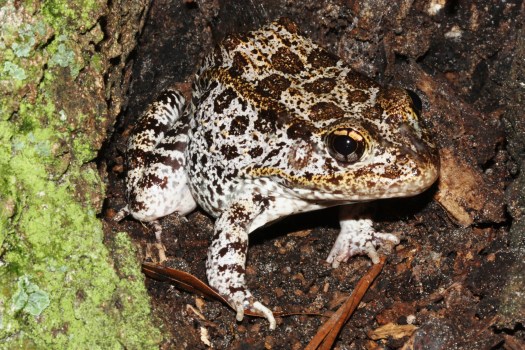By Allison Vincent

Rare sights and sounds abound throughout the CREW trails, especially when compared to the urbanized communities most of us call home. Nevertheless, some species are considerably more rare to see or hear even within the preserved lands of CREW. One such species is the gopher frog, Lithobates capito, a stout-bodied, boldly spotted frog with a chunky appearance that reaches a length of two to four inches. Within the CREW lands, they have their own specialized communities and you can find them in xeric hammock, scrubby and mesic flatwoods, mixed hardwood-pine communities and a variety of disturbed habitats.

Xeric hammock

Scrubby flatwoods

Mesic flatwoods

Hardwood-pine community
This species gets its name from it’s homely use of gopher tortoise burrows. Gopher frogs are nocturnal, normally spending their day in tunnels, stump holes, and gopher tortoise burrows. However, because of habitat destruction, the gopher frog is very rare in its southern range of south Florida, and is listed as a FWC species of special concern in Florida.
Pivotal to the success of future generations of gopher frogs is land management and preservation, like the work you support at CREW. Prescribed fire and shredding of vegetation in the understory of their ecosystems helps to eliminate small shrubby tree encroachment, dense debris, peat buildup, and increased evapotranspiration (evaporation of surface water and release of water vapor).
Partnership between the Florida Fish and Wildlife Conservation Commission (FWC) wildlife biologists and the South Florida Water Management District land managers ensures that habitat restoration takes place within the CREW project which in turn greatly benefits environmental sensitive species like the gopher frog.
FWC biologists at CREW have recently reignited research on game and predaceous fish, another threat to gopher frog populations.

In Search of a Mate
Gopher frogs will travel long distances (up to a mile or more) to breed mainly in seasonally flooded, temporary breeding ponds, but also in permanent waters. The gopher frogs occurring in southern Florida will breed a second time in the summer. Females lay eggs in shallow water in a single mass that can contain 3,000 to 7,000 eggs. Once hatched, the tadpoles metamorphose in three to seven months. Gopher frogs usually reach sexual maturity at two years of age.
Listen for the Chorus
The call of a gopher frog is developed in the back of the mouth and sounds like a deep guttural snore. Heavy rains at any season may stimulate choruses, resulting with many of them calling at once. Sometimes they call from underwater, so as not to attract predators, creating a noise that is detected only by a hydrophone, which is defined exactly as the name implies, a microphone which detects sound waves underwater.
Listen to sound recordings of gopher frog calls among other Florida species



